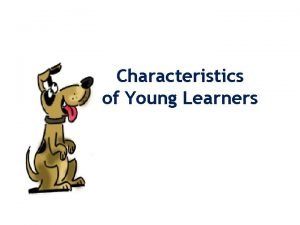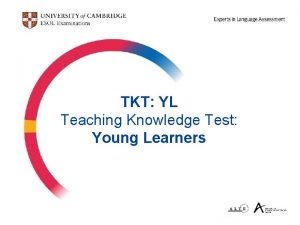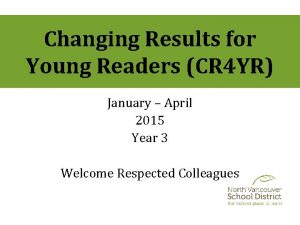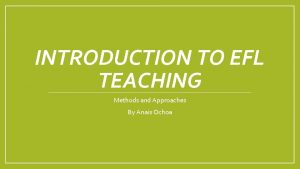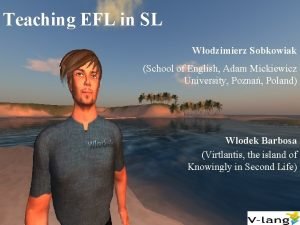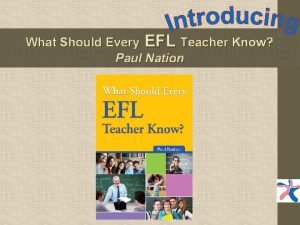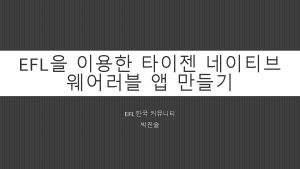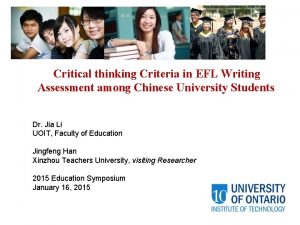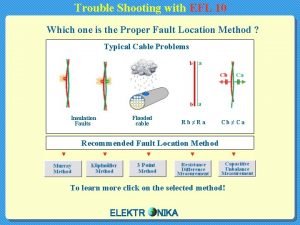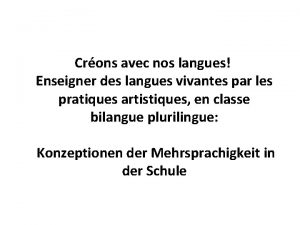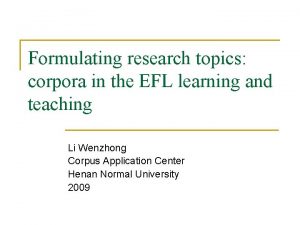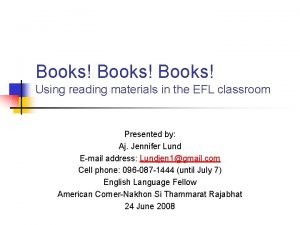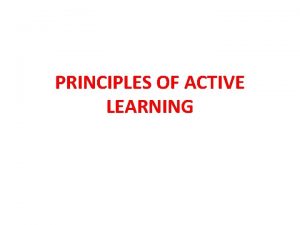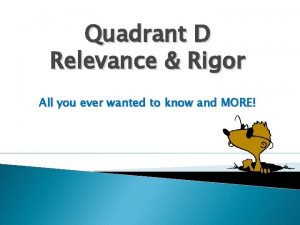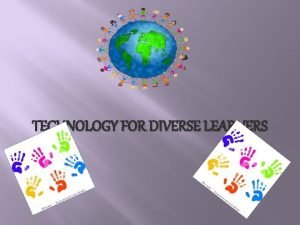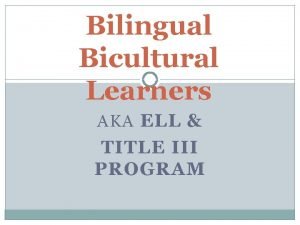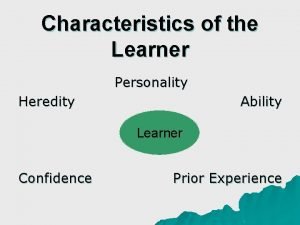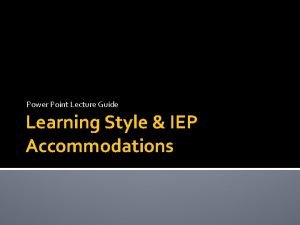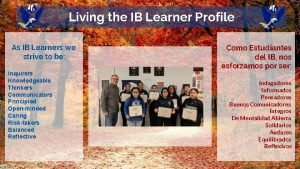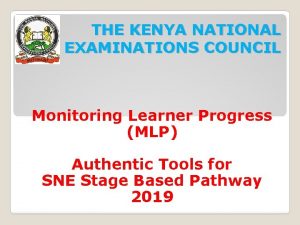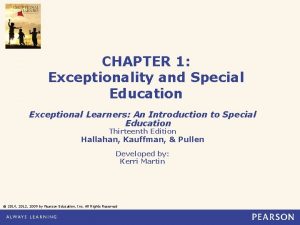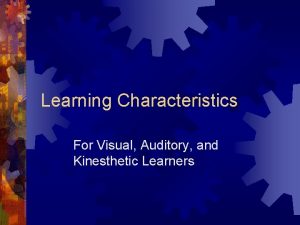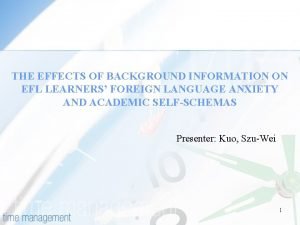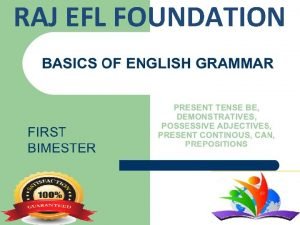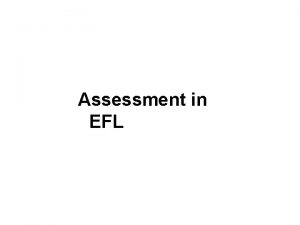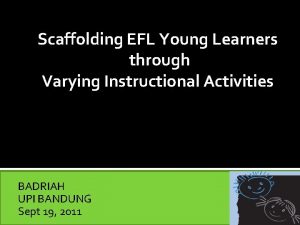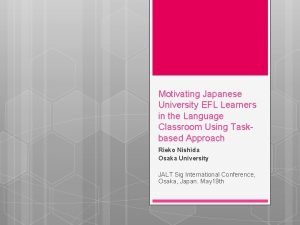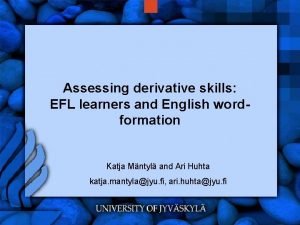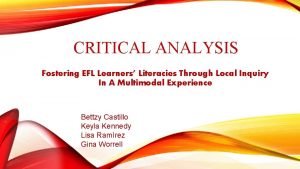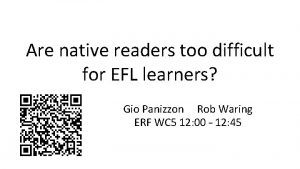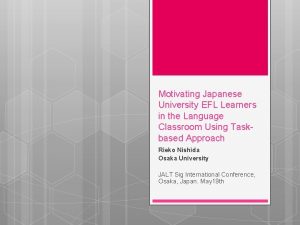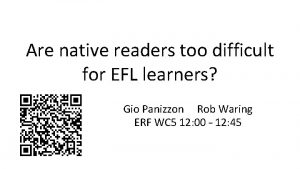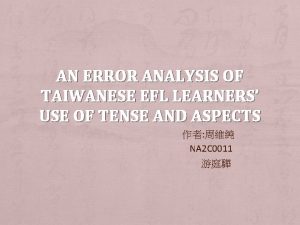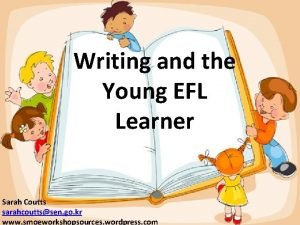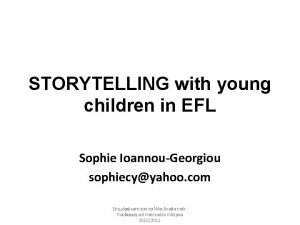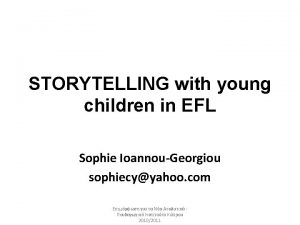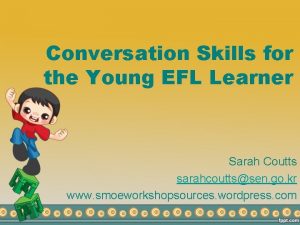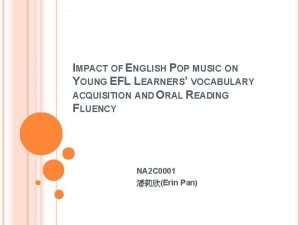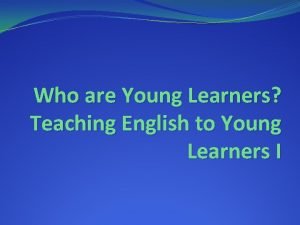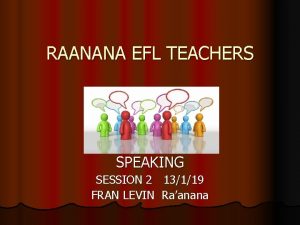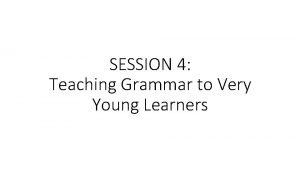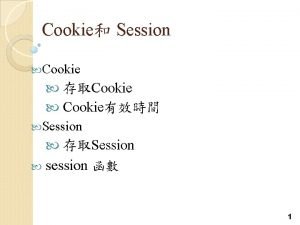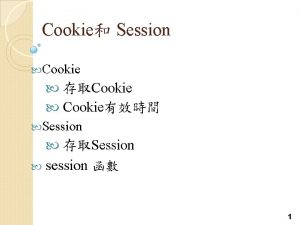SESSION 1 YOUNG EFL LEARNERS Young Learners vs































- Slides: 31

SESSION 1: YOUNG EFL LEARNERS

Young Learners vs. Very Young Learners Young learners (YLs) = 7 -12 years old Very young learners (VYLs) = under 7 years old (Shin, 2006; Shin, 2014)

Question Is starting English instruction earlier (in preprimary or primary school grades) better? • Yes • No

Earlier is not necessarily better! • Young learners are not the most efficient language learners (Ellis, 1984) • Students starting in high school can attain native-like pronunciation (Singleton, 1995) • 35 studies in the past 30 years, only 14 showed support for a critical period for L 2 acquisition (Marinova-Todd, Marshall, & Snow, 2000)

Is earlier really better? Value of increased time Better pronunciation Better fluency Greater global awareness Mental flexibility

Can early dual language learning be detrimental to children? • “There is no significant theoretical reason to believe that learning, knowing, or using two languages should jeopardize children’s development. ” (Genessee, Paradis, & Crago, 2011) • Cognitive advantages among bilingual children are usually associated with advanced levels of bilingual proficiency (Cummins, 2000)

What can we do to take advantage of the flexibility of young minds and the malleability of young tongues to grow better speakers of English?

KNOW YOUR YOUNG LEARNERS

Adjective Splash With a partner, take out a blank piece of paper. Together you will brainstorm adjectives that describe young learners. You have one minute. Write down as many adjectives as you can on the piece of paper. You can “splash” them down anywhere on the page.

Characteristics of Young Learners HYPER ENERGETIC CAN’T SIT STILL SPONTANEOUS TALKATIVE SOCIAL EASILY DISTRACTED CURIOUS SILLY FUN

How do children learn? • Children are active learners and thinkers. (Piaget, 1970) • Children learn through social interaction. (Vygotsky, 1962) • Children learn effectively through scaffolding by adults. (Bruner, 1983)

Effective scaffolding (Bruner, 1983) Create interest Break it down Model expectations Show different ways Remind them of purpose Control frustration

Scaffolding language input Use visuals, e. g. , pictures and flashcards Use gestures, body movement, realia Use graphic organizers, e. g. , Venn diagram, T-chart

Scaffolding language input • Pronounce words clearly • Speak slower (without distorting the natural flow) • Repeat and rephrase • Use shorter and simpler sentences and phrases • Model expected utterances and responses • Translate difficult words (when necessary)

Language learning environment L 1 environment • Language highly contextualized • Language used is authentic • Learner is highly motivated L 2 environment • Language more decontextualized Language learning • Language used more environment artificial • Learners may not be highly motivated

Approach to teaching young learners • • Promote active learning Encourage social interaction Scaffold students’ learning Make input comprehensible Try to imitate the L 1 environment Make learning meaningful Make English fun!

LEARNER DIFFERENCES BY AGE

Piaget’s (1963) Stages of Cognitive Development

Preoperational Stage 2 -7 years old • show intelligence through strides they make in language development • are extremely egocentric and have difficulty seeing things from another’s perspective • develop memory and imagination • do not think logically

Concrete Operations Stage 7 -11 years old • show intelligence through logical and organized thought related to concrete objects • are less egocentric but still have a tendency to relate new ideas to themselves and their immediate surroundings • can reverse their thinking through reasoning

Formal Operations Stage 11 years and older • show intelligence through logical use of symbols related to abstract concepts • can hypothesize and use deductive reasoning

Egan’s (1992) Layers of Educational Development

The Mythic Layer 4 -5 to 9 -10 years old • Have vivid imaginations (animals can talk, magic is real) • Are very emotional and focus on how they feel • Make sense of things through emotional and moral categories (good vs. bad; happy vs. sad) • Are drawn in by polar opposites (very tiny vs. really huge; freezing cold vs. burning hot; wicked witch vs. perfect princess) • Interpret the world in absolutes (wicked witch is all bad; daring prince is all good) • Story form is ideal approach

The Romantic Layer 8 -9 to 14 -15 years old • Begin to separate the world around them from their internal world; developing a sense of their own identity • See the outside world as fascinating and frightening • Like learning about “transcendent” qualities that overcome the frightening world (courage, genius, ambition, energy, creativity) • Attracted to extremes (the highest mountain, the longest word) • Attracted to realistic detail (the more different from their own experience, the better) • Like collecting things (stamps, or amazing facts about a country) • Story form still important (with emphasis on realistic detail and real life heroes and heroines)

The Philosophic Layer 14 -15 to 19 -20 years old • Organize the facts and details they collected in the Romantic Layer, creating their own systems for making sense of the world • Tend to believe they have found the system and become (over)confident that they know the meaning of everything

The Ironic Layer 19 -20 through adulthood • Recognizes that no one system is adequate to organize all knowledge, but that systems are necessary to make sense of information • Understands that if one system does not work well, it can be discarded in favor of another one. • This is the mature, adult learner

Curtain & Dahlberg (2016) Language Classroom Considerations

Preschool Children (2 -4 years old) Are in a sensitive period for language development Absorbs languages effortlessly Adept imitators of speech sounds Self-centered, do not work well in groups Respond best to activities related to their own interests and experiences • Short attention spans • Enjoy repetition of activities and games they like • Respond well to concrete experiences and large motor involvement in language learning • • •

Primary Students (5 -7 years old) • Learn best with concrete experiences and immediate goals • Learn new concepts and vocabulary better when presented as pairs of binary opposites • Like to name objects, define words, and learn about things in their own world • Have vivid imaginations; respond well to stories and fantasy • Learning through oral language; can develop good oral skills, pronunciation, and intonation with good models • Learn well through dramatic play, role-play, and use of story form with a strong beginning, middle, and end • Have short attention spans; need a great variety of activities • Require large muscle activity; working on small-muscle skills • Need specific directions and work well with routines

Intermediate Students (8 -10 years old) • Are at maximum openness to people and situations different from their own experiences; a global emphasis extremely important • Begin to understand cause and effect • Can begin a more systematic approach to language learning • Can work well in groups; may not like to partner with opposite sex • Still like experiences with imagination and fantasy, especially with binary opposites, strong emotional connection to what is learned, and story form with distinctive beginning, middle, and end • Like themes based on heroes and heroines who display transcendent qualities to overcome challenges in life • Need context for language learning; can bring together vocabulary and functional chunks learn in earlier years and can apply them in more complex situations

Early Adolescent Students (11 -14 years old) • Have multiplying and rapidly shifting interests • Have strong need to assert interdependence with peer group • Need encouragement to develop positive self image • Respond well to opportunities to learn in exhaustive detail about subjects that interest them • Like heroic figures with qualities that transcend threats • Need learning experiences with strong affective component • Show high interest in unusual extremes in the real world • Respond well content-based unit with a definite culminating projects (skits, video presentations, posters, murals)
 Characteristics of attention
Characteristics of attention Tkt: yl resources
Tkt: yl resources Teaching young learners english
Teaching young learners english What is grammar
What is grammar Changing results for young learners
Changing results for young learners Efl
Efl Efl poznań
Efl poznań What should every efl teacher know pdf
What should every efl teacher know pdf Uifw
Uifw Dr ray efl
Dr ray efl Efl 10
Efl 10 Efl epreuve facultative uf
Efl epreuve facultative uf Efl research topics
Efl research topics Efl reading materials
Efl reading materials Active learning principles
Active learning principles Quadrant d learners
Quadrant d learners Learn to learn
Learn to learn Technology for diverse learners
Technology for diverse learners English language learners
English language learners Characteristic of learners
Characteristic of learners Global vs analytical learners
Global vs analytical learners Ib learners profile
Ib learners profile Questioning and discussion techniques in the classroom
Questioning and discussion techniques in the classroom Government program for gifted students in the philippines
Government program for gifted students in the philippines When is cognitivism beneficial for learners
When is cognitivism beneficial for learners Active and passive learners
Active and passive learners Knec monitoring learners' progress
Knec monitoring learners' progress Reading strategies for english language learners
Reading strategies for english language learners Exceptional learners: an introduction to special education
Exceptional learners: an introduction to special education Characteristics of a kinesthetic learner
Characteristics of a kinesthetic learner Cr part 154
Cr part 154 Background information for learners
Background information for learners
